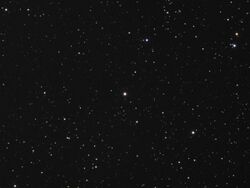Astronomy:HD 49674
| Observation data Equinox J2000.0]] (ICRS) | |
|---|---|
| Constellation | Auriga |
| Right ascension | 06h 51m 30.51634s[1] |
| Declination | +40° 52′ 03.9256″[1] |
| Apparent magnitude (V) | 8.10[2] |
| Characteristics | |
| Spectral type | G3V[3] |
| B−V color index | 0.729±0.015[2] |
| Astrometry | |
| Radial velocity (Rv) | 11.97±0.27[1] km/s |
| Proper motion (μ) | RA: 34.587[1] mas/yr Dec.: −122.797[1] mas/yr |
| Parallax (π) | 23.2054 ± 0.0411[1] mas |
| Distance | 140.6 ± 0.2 ly (43.09 ± 0.08 pc) |
| Absolute magnitude (MV) | 4.88[2] |
| Details | |
| Mass | 1.07±0.02[4] M☉ |
| Radius | 1.01±0.01[4] R☉ |
| Luminosity | 0.96±0.01[4] L☉ |
| Surface gravity (log g) | 4.46±0.02[4] cgs |
| Temperature | 5,702±28[4] K |
| Metallicity [Fe/H] | 0.34±0.06[3] dex |
| Rotational velocity (v sin i) | 4.7[5] km/s |
| Age | 1.8±1.2[4] Gyr |
| Other designations | |
| Database references | |
| SIMBAD | data |
HD 49674 is a solar-type star with an exoplanetary companion[7] in the northern constellation of Auriga. It has an apparent visual magnitude of 8.10[2] and thus is an eighth-magnitude star that is too faint to be readily visible to the naked eye. The system is located at a distance of 140.6 light-years from the Sun based on parallax, and is drifting further away with a radial velocity of +12 km/s.[1]
HD 49674, and its planetary system, was chosen as part of the 2019 NameExoWorlds campaign organised by the International Astronomical Union, which assigned each country a star and planet to be named. HD 49674 was assigned to Belgium. The winning proposal named the star Nervia and the planet Eburonia, both after prominent Belgic tribes, the Nervii and Eburones, respectively.[8]
This is an ordinary G-type main-sequence star with a stellar classification of G3V,[3] which indicates it is generating energy through hydrogen fusion at its core. Spinning with a projected rotational velocity of 4.7 km/s,[5] it is younger than the Sun, roughly two billion years of age, and is a metal-rich star.[7] HD 49674 has a similar mass and radius as the Sun. It is radiating 96% of the Sun's luminosity from its photosphere at an effective temperature of 5,702 K.[4]
Planetary system
At the time of discovery of the planet HD 49674 b in 2002, it was the least massive planet known, very close to the boundary between sub-Jupiter mass and Neptune mass at 0.1 MJ. This planet orbits very close to the star, with a semimajor axis of 0.0580 astronomical unit|AU (8.68 Gm).[9]
| Companion (in order from star) |
Mass | Semimajor axis (AU) |
Orbital period (days) |
Eccentricity | Inclination | Radius |
|---|---|---|---|---|---|---|
| b / Eburonia | >0.105 ± 0.011 MJ | 0.0580 ± 0.0034 | 4.94737 ± 0.00098 | 0.087 ± 0.095 | — | — |
See also
References
- ↑ 1.0 1.1 1.2 1.3 1.4 1.5 1.6 Brown, A. G. A. (August 2018). "Gaia Data Release 2: Summary of the contents and survey properties". Astronomy & Astrophysics 616: A1. doi:10.1051/0004-6361/201833051. Bibcode: 2018A&A...616A...1G. Gaia DR2 record for this source at VizieR.
- ↑ 2.0 2.1 2.2 2.3 Anderson, E.; Francis, Ch. (2012). "XHIP: An extended hipparcos compilation". Astronomy Letters 38 (5): 331. doi:10.1134/S1063773712050015. Bibcode: 2012AstL...38..331A.
- ↑ 3.0 3.1 3.2 Grieves, N. et al. (December 2018). "Chemo-kinematics of the Milky Way from the SDSS-III MARVELS survey". Monthly Notices of the Royal Astronomical Society 481 (3): 3244–3265. doi:10.1093/mnras/sty2431. Bibcode: 2018MNRAS.481.3244G.
- ↑ 4.0 4.1 4.2 4.3 4.4 4.5 4.6 Bonfanti, A. et al. (2015). "Revising the ages of planet-hosting stars". Astronomy and Astrophysics 575: A18. doi:10.1051/0004-6361/201424951. Bibcode: 2015A&A...575A..18B. http://www.aanda.org/articles/aa/full_html/2015/03/aa24951-14/aa24951-14.html.
- ↑ 5.0 5.1 Luck, R. Earle (January 2017). "Abundances in the Local Region II: F, G, and K Dwarfs and Subgiants". The Astronomical Journal 153 (1): 19. doi:10.3847/1538-3881/153/1/21. 21. Bibcode: 2017AJ....153...21L.
- ↑ "HD 49674". SIMBAD. Centre de données astronomiques de Strasbourg. http://simbad.u-strasbg.fr/simbad/sim-basic?Ident=HD+49674.
- ↑ 7.0 7.1 Butler, R. Paul et al. (2003). "Seven New Keck Planets Orbiting G and K Dwarfs". The Astrophysical Journal 582 (1): 455–466. doi:10.1086/344570. Bibcode: 2003ApJ...582..455B. http://www.iop.org/EJ/article/0004-637X/582/1/455/56131.html.
- ↑ "Belgium" (in en). http://www.nameexoworlds.iau.org/belgium.
- ↑ 9.0 9.1 Butler, R. P. et al. (2006). "Catalog of Nearby Exoplanets". The Astrophysical Journal 646 (1): 505–522. doi:10.1086/504701. Bibcode: 2006ApJ...646..505B. http://www.iop.org/EJ/article/0004-637X/646/1/505/64046.html.
External links
- "Notes for star HD 49674". Extrasolar Planets Encyclopaedia. http://exoplanet.eu/star.php?st=HD+49674. Retrieved 2008-08-23.
- HIP 32916 Catalog
- Image HD 49674
Coordinates: ![]() 06h 51m 30.5164s, +40° 52′ 03.923″
06h 51m 30.5164s, +40° 52′ 03.923″
 |


